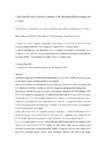Mostrar o rexistro simple do ítem
Clinical profile and evolution of patients with subarachnoid haemorrhage for 11 years
| dc.contributor.author | Mourelo-Fariña, Mónica | |
| dc.contributor.author | Galeiras, Rita | |
| dc.contributor.author | Aller Fernández, Ana Vanesa | |
| dc.date.accessioned | 2022-12-16T12:18:39Z | |
| dc.date.available | 2022-12-16T12:18:39Z | |
| dc.date.issued | 2021-01-01 | |
| dc.identifier.citation | Mourelo-Fariña M, Galeiras R, Pértega S, Aller AV. Clinical profile and course of patients with subarachnoid haemorrhage for 11 years. Neurocirugia (Astur : Engl Ed). 2021 Jan-Feb;32(1):10-20. English, Spanish. | es_ES |
| dc.identifier.issn | 2529-8496 | |
| dc.identifier.uri | http://hdl.handle.net/2183/32213 | |
| dc.description | Clinical research | es_ES |
| dc.description.abstract | [Abstract] Introduction: Spontaneous subarachnoid haemorrhage is a rare cause of stroke, but it causes great socioeconomic impact and high morbidity and mortality. The aim of this study is to describe the clinical profile and evolution of a series of patients with SAH admitted to a tertiary hospital, as well as the diagnostic and therapeutic management. Material and methods: Retrospective study of 536 patients diagnosed with SAH admitted to the ICU of the Hospital Universitario de A Coruña between 2003 and 2013 (Age: 56.9±14.1 years, female/male ratio: 1.5:1). Demographic characteristics, risk factors, aetiologies and clinical signs, prognostic scales, diagnostic tests and treatment were collected. A comparative analysis was made between the general series and subgroups of patients with aneurysmal (SAH-A) and idiopathic (SAH-I) subarachnoid haemorrhage. Results: There were 49.0±15.1 patients/year (2013 incidence: 4.3/100,000 inhabitants). 60.3% presented Glasgow Coma Scale 14-15, with scarce symptomatology (Hunt-Hess I-II 61.9%, World Federation Neurosurgeons Scale I-II 60.4%). 50.7% presented Fisher IV. SAH-A was diagnosed in 78.3% (n=396); perimesencephalic subarachnoid haemorrhage (SAH-PM) in 3.2%; and SAH-I in 17.9%. During the study period there was an increase in the prevalence of aneurysms, causing an increased number of surgeries in recent years. Both SAH-A and SAH-I presented greater severity upon admission. Patients with SAH-A had higher percentage of complications and mortality, with lesser degree of independence at 6 and 12 months. Conclusions: The incidence of SAH appears to have decreased in recent years, with SAH-I comprising 17.9% of the cases. Patients with SAH-I have better prognosis and lower risk of complications, highlighting the benignity of SAH-PM. | es_ES |
| dc.description.abstract | [Resumen] Introducción. La hemorragia subaracnoidea espontánea es una causa poco frecuente de ictus que ocasiona gran impacto socioeconómico y elevada morbimortalidad. El objetivo de este estudio es describir el perfil clínico y evolución de una serie de pacientes con HSA ingresados en un hospital terciario, así como el manejo diagnóstico-terapéutico. Material y métodos. Estudio retrospectivo de 536 pacientes diagnosticados de HSA ingresados en la Unidad de Cuidados Intensivos del Hospital Universitario de A Coruña de 2003–2013 (edad: 56,9 ± 14,1 años, ratio mujer/hombre:1,5:1). Se recogieron características demográficas, factores de riesgo, etiología y clínica, escalas pronósticas, pruebas diagnósticas y tratamiento. Se realizó un análisis comparativo entre la serie general y subgrupos de pacientes con HSA aneurismática (HSA-A) e idiopática (HSA-I). Resultados. Se registraron 49,0 ± 15,1 pacientes/año (incidencia 2013:4,3/100.000 habitantes). 60,3% presentaban Glasgow Coma Scale 14-15, con escasa sintomatología (Hunt-Hess (H-H) I-II 61,9%; World Federation Neurosurgeons Scale (WFNS) I-II 60,4%). 50,7% presentaban Fisher IV. En 78,3%(n = 396) se diagnosticó HSA-A, 3,2% presentaban sangrado perimesencefálico (HSA-PM) y HSA-I 17,9%. Durante el periodo de estudio se registró aumento de la prevalencia de aneurismas, incrementándose en los últimos años la cirugía. Tanto la HSA-A como HSA-I presentaban mayor gravedad al ingreso. Los pacientes con HSA-A presentaron mayor porcentaje de complicaciones y mortalidad, con menor grado de independencia a 6 y 12 meses. Conclusiones. La incidencia de HSA tiende a descender en los últimos años, representando la HSA-I el 17,9% de los casos. Los pacientes con HSA-I tienen mejor pronóstico y menor riesgo de complicaciones, destacando la benignidad de la HSA-PM. | es_ES |
| dc.language.iso | eng | es_ES |
| dc.publisher | Elsevier | es_ES |
| dc.relation.uri | https://doi.org/10.1016/j.neucie.2020.08.005 | es_ES |
| dc.subject | Spontaneous subarachnoid haemorrhage | es_ES |
| dc.subject | Intracranial aneurysm | es_ES |
| dc.subject | Perimesencephalic haemorrhage | es_ES |
| dc.subject | Vasospasm | es_ES |
| dc.subject | Clipping | es_ES |
| dc.subject | Prognosis | es_ES |
| dc.subject | Hemorragia subaracnoidea espontánea | es_ES |
| dc.subject | Aneurisma intracraneal | es_ES |
| dc.subject | Hemorragia perimesencefálica | es_ES |
| dc.subject | Vasoespasmo | es_ES |
| dc.subject | Pinzamiento | es_ES |
| dc.subject | Pronóstico | es_ES |
| dc.title | Clinical profile and evolution of patients with subarachnoid haemorrhage for 11 years | es_ES |
| dc.title.alternative | Perfil clínico y evolución de pacientes con hemorragia subaracnoidea durante 11 años | es_ES |
| dc.type | info:eu-repo/semantics/article | es_ES |
| dc.rights.access | info:eu-repo/semantics/openAccess | es_ES |
| UDC.journalTitle | Neurocirugía (English Edition) | es_ES |
| UDC.volume | 32 | es_ES |
| UDC.issue | 1 | es_ES |
| UDC.startPage | 10 | es_ES |
| UDC.endPage | 20 | es_ES |
Ficheiros no ítem
Este ítem aparece na(s) seguinte(s) colección(s)
-
INIBIC-ECB - Artigos [50]






